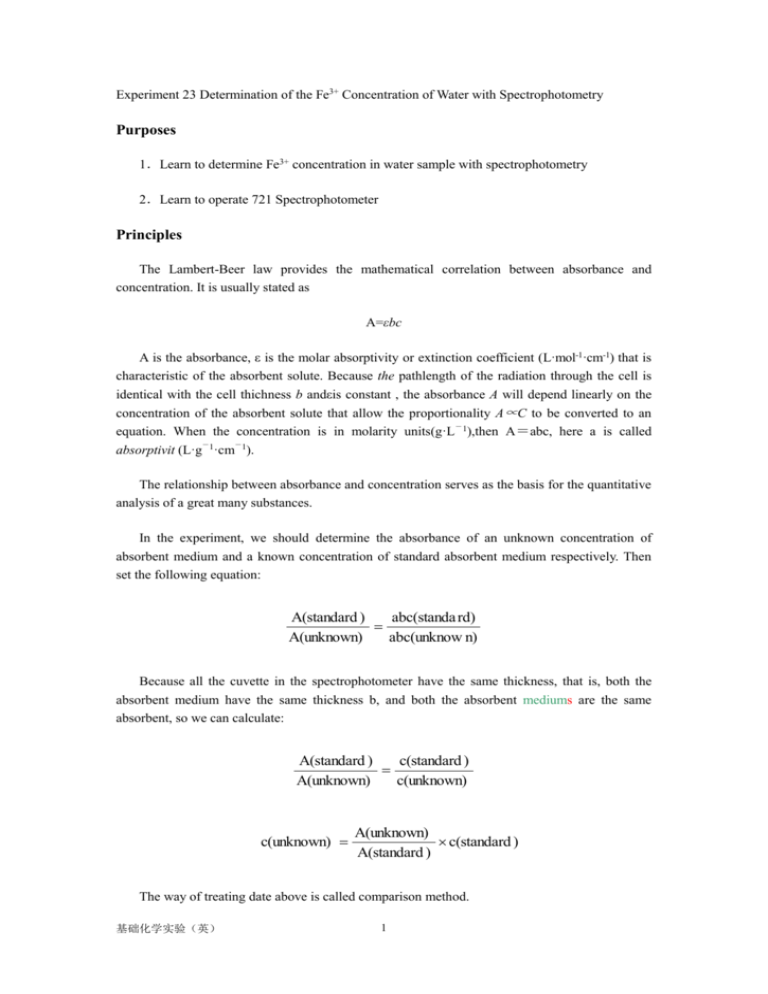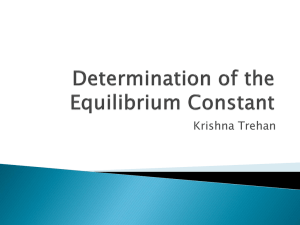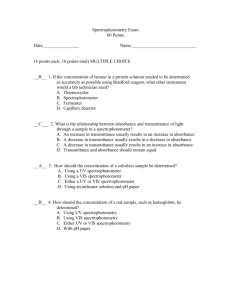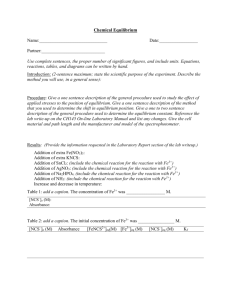基础化学实验
advertisement

Experiment 23 Determination of the Fe3+ Concentration of Water with Spectrophotometry Purposes 1.Learn to determine Fe3+ concentration in water sample with spectrophotometry 2.Learn to operate 721 Spectrophotometer Principles The Lambert-Beer law provides the mathematical correlation between absorbance and concentration. It is usually stated as A=εbc A is the absorbance, ε is the molar absorptivity or extinction coefficient (L·mol-1·cm-1) that is characteristic of the absorbent solute. Because the pathlength of the radiation through the cell is identical with the cell thichness b andεis constant , the absorbance A will depend linearly on the concentration of the absorbent solute that allow the proportionality A∝C to be converted to an - equation. When the concentration is in molarity units(g·L 1),then A=abc, here a is called - - absorptivit (L·g 1·cm 1). The relationship between absorbance and concentration serves as the basis for the quantitative analysis of a great many substances. In the experiment, we should determine the absorbance of an unknown concentration of absorbent medium and a known concentration of standard absorbent medium respectively. Then set the following equation: A(standard ) abc(standa rd) A(unknown) abc(unknow n) Because all the cuvette in the spectrophotometer have the same thickness, that is, both the absorbent medium have the same thickness b, and both the absorbent mediums are the same absorbent, so we can calculate: A(standard ) c(standard ) A(unknown) c(unknown) c(unknown) A(unknown) c(standard ) A(standard ) The way of treating date above is called comparison method. 基础化学实验(英) 1 In practice, in order to omit the calculation and increase the accuracy of the determination, the absorbances of a series of solutions of known concentrations are measured and a plot of absorbance versus concentration is prepared. Such a plot represents a standard curve (or working curve) for the particular system being studied. An unknown solution containing the same absorbent substance may then be analyzed by measuring its absorbance, locating it’s a value on the working curve, and reading the corresponding concentration. That concentration of sample solution is measured by working curve this way is called working curve method. Different substances have different ability to absorb the different light of different wavelength. According to the shape of the curve of absorption spectrum, the λ of the absorption peak, and the relationship between the absorbance and the concentration, and spectrophotomatry can be the qualitative analysis. The spectrophotometry usually uses the optimum wavelength. A graphical plot of absorbance versus wavelength is referred to as an absorption spectrum. These are prepared by measuring the light absorbed by a solution with different known wavelength. By referring to your plots of absorbance versus wavelength, select λmax to study the relationship between the absorbance and concentration. Moreover, the acidity of the solution, the amount of the color developing reagent, the temperature of coloration, the time and the substances, and so on. All these facts can affect the determination. You can choose a proper condition of determination. 1 O-phenanthroline Method In spectrophotometric determination of trace of Fe3+ ions, 1, 10-phenanthroline is a sensitive color-developing agent, with which a complex of Fe2+ is formed to give orange red color (lgKs=21.3). As this colored solution is measured with a spectrophotometer, maximum absorbance is observed at 510nm. Molar absorption coefficient is equal to 1.1×104L·mol-1·cm-1. In the range of pH 3 to 9, the complex is very stable. Iron must be in ferrous state and hence a reducing agent is added before the color is developed. Hydroxylamine hydrochloride can be used to reduce Fe3+ to Fe2+. These reactions are given below:. - 2Fe3++2NH2OH·HCl=2Fe2++N2↑+2H2O+4H++2Cl 2+ N N + 3 2+ = Fe N Fe N 3 1.1 Apparatus and Reagents Apparatus: 721-Spectrophotometer, volumetric flask (50mL×7), measuring pipets (1mL, 2mL×2, 5mL, 10mL), analytical balance, sucker 基础化学实验(英) 2 Reagents: 8mmol·L-10-Phenanthroline (fresh), 1.5mol·L-1 hydroxylamine hydrochloride (fresh), 1mol·L-1 sodium acetate, standard ferrous sulfate solution (2.000mmol·L-1) 1.2 Procedure 1. Preparation of standard solutions and sample solutions of iron. According to the volumes of various reagents listed in the table below. Pipet reagent solution into each of the seven volumetric flasks. Fill them with distilled water to the assigned volume and mix thoroughly. According to the table listed below to prepare seven solutions with volumetric flash and measuring pipet. The seven solutions are the blank solution, a serial of standard solution and the sample solution. Table Ⅱ-1 Preparation of the working curve and determination of trace Fe3+ ions in a sample solution Experiment No. Fe2+standard/mL NaOH/mL HCl/mL NaAc/mL c(Fe2+ diluted)/μg·L-1 1 (blank) 2 3 4 5 6 7 0 0.40 0.80 1.20 1.60 2.00 1.0 2.0 5.0 1.0 2.0 5.0 1.0 2.0 5.0 1.0 2.0 5.0 1.0 2.0 5.0 1.0 2.0 5.0 10.00mL sample 1.0 2.0 5.0 Absorbance (A) 2. Determination of absorption spectrum Before the experiment, be sure to read the operation manual of spectrophotometer carefully. Set the wavelength dial at 450nm, and adjust the instrument to read 0% T with no cuvette and 100%T when the reagent blank (No. 1 solution)-filled cuvette is in the sample holder. Place No. 4 of table Ⅱ-8-1 standard solution in your second cuvette and insert it into the sample holder. Read the A of the standard solution from the dial. Repeat this procedure at 10-nm intervals from 450nm to 560nm. Be sure to set the instrument to 0% absorbance and 100%T with the blank solution after each change of the wavelength. Weight 0.7842g of (NH4)2Fe(SO4)2·6H2O accurately, put it into a beaker, add 120mL of hydrochloric acid (6 mol·L-1) and small volume distilled water to dissolve it. Then transfer the solution to a 1000mL volumetric flask and fill to mark with distilled water. Homogenize the solution by shaking the flask. 基础化学实验(英) 3 Table Ⅱ-2 The determination of absorption spectrum λ(nm) A λmax Absorption spectrum: 3. Preparation of the working curve Transfer the standard solutions and blank solution to clean cuvettes, and determine the absorbance for each of the five standard solutions at the wavelength that corresponds to maximum absorption for the absorption spectrum, use the blank solution as reference. Prepare a working curve by plotting absorbance (ordinate) versus the concentration of Fe2+ (abscissa). 4. Determination of trace Fe3+ ions in a sample solution Under the same conditions with Determination of the working curve, determine the A of the sample solution, and then find out the concentration of Fe3+ ions by using the comparison method and the working curve method respectively. 1.3 Questions 1. Why is the absorbance of the solution better to be controlled in the range of 0.2-0.8? How to controlled it? 2. Is the concentration of Fe3+ ions found out on the working curve the concentration of Fe3+ ions of the original sample solution? 3. According to this experiment, point out the advantage and disadvantage of comparison method and working curve method. 2 Sulfocyan (MCNS) Method Principle Visible spectrometry only apply to the colored materials, but dilute solution of Fe3+ ions is almost colorless. KCNS is used as a color development reagent in our experiment. Fe3+ ion can react with CNS- ion and produce red [Fe (CNS) 6]3- complex ion (lgKs=6.4): Fe3+ + 6 CNS- [Fe (CNS) 6]3- The gradation of color of the solution will be in proportion to the concentration of Fe3+ ions In this experiment, the concentration of CNS- must be much larger than the concentration it needs 基础化学实验(英) 4 to react with Fe3+ ions. Some HNO3 should be added into the sample solution to prevent the Fe3+ ions from hydrolysising. Furthermore, Fe3+ ions will be reduced to Fe2+ ions by CNS- ions slowly, so (NH4)2S2O8 also should be added into the sample solution as a strong oxidant to prevent Fe3+ ions from being reduced. 2.1 Apparatus and Reagents Apparatus: 721-type spectrophotometer, volumetric flasks (50mL, 1000mL), measuring pipets (5mL, 10mL), sucker Reagents: 4mol·L-1 KCNS, HNO3 (1:1), concentrated H2SO4, Fe3+ standard solution 2.2 Procedure 1. Prepare standard solutions and a water sample solution Get 7 volumetric flasks (50mL) and use the measuring pipets to transfer those solutions into the volumetric flasks (according to the tableⅡ- 8-3). Add distilled water until the meniscus descends to the ring mark. Now we get a series of standard solutions, blank solution and water sample solution, each of them has a different concentration of Fe3+ ions. TableⅡ-8-3: Preparation of Fe3+ standard solutions and a water sample solution Experiment NO. Fe3+ standard solution /mL 1 (Blank solution) 2 3 4 5 6 0 0.50 1.00 1.50 2.00 2.50 1.0 5.00 1.0 5.00 1.0 5.00 1.0 5.00 1.0 5.00 1.0 5.00 2.5%NH4Fe(SO4)2 /drop 1 1 1 1 1 1 c(Fe3+)/mg·L-1 0 1.00 2.00 3.00 4.00 5.00 HNO3 /mL 4mol·L-1KCNS /mL 7 10.00 (water sample) 1.0 5.00 2. Determination of absorption spectrum Here we use 721-type spectrophotometer to determine the absorbance of NO.4 of tableⅡ-8-3 standard solution by the homogeneous light from 400nm to 560nm. Use blank solution as reference solution. Determine the absorbance of No. 4 standard solution once per 10nm-20nm Preparation of 0.1mg /1.00mL Fe3+ standard solution: Weigh 0.8640g NH4Fe (SO4)2·12H2O, dissolve it with a little distilled water and then add 5mL concentrated H2SO4 to the solution. Allow the solution to cool to room temperature, pour it into a volumetric flask (1000mL), and add distilled water until the meniscus descends to the ring mark. (0.1mg /1.00mL Fe3+solution) 基础化学实验(英) 5 from 400nm-560nm. Record the results and draw an absorption spectrum. Find the maximum absorption of the wavelength (λmax). TableⅡ-8-4 Determination of absorption spectrum λ/nm Absorbance (A) λmax 3. Determination of absorbance (A) According to the usage of 721-type spectrophotometer, select the λmax from the absorption spectrum which you have determined above, or use λ=480nm (this wavelength is from some reference books). Select suitable sensitivity of the spectrophotometer and use blank solution as reference solution to determine absorbance of each standard solution and water sample solution. Record the results. 4. Draw a working curve + Draw a working curve. The abscissa is the concentration of Fe3 ordinate is the absorbance of the standard solutions. of standard solutions, the 5. Determine the [Fe3+] of water sample solution. We can look up the concentration of the unknown solution from the working curve after its absorbance was determined by comparison method and working curve method. 2.3 Questions + 1. Why should we add excess KCNS solution during the color reaction of Fe3 ion? 3 Sulfosalicylic Acid Method Principle Fe3+ ions can react with sulfosalicylic acid (H2Ssal) and produce many kinds of complex ion. The complex ion has different composition and different color under different pH environment. For example, a violet red [FeSsal]+ ion is formed under pH=1.8-2.5, a brown [Fe (Ssal) 2]- ion is formed under pH=4-8 and a stable yellow [Fe (Ssal) 3]3- ion is formed under pH = 8.0~11.5. Fe3+ ion is prone to hydrolysis and produce precipitation, Fe (OH) 3 when pH>12. Colorimetric determination is impossible to perform under this condition. So this method should be used under pH<12 and pH should be kept as a constant. In this experiment, we use Fe3+ ions to react with sulfosalicylic acid and produce brown [Fe (Ssal) 2]- ions under a condition of HAc-NaAc buffer solution (pH=5). Determine the absorbance with λ=466nm 3.1 Apparatus and Reagents 基础化学实验(英) 6 Apparatus: 721-type spectrophotometer, volumetric flasks (50mL×8), measuring pipets (5mL, 10mL), sucker Reagents: 0.1g·L-1 Fe3+ standard solution (, formulation is same as ‘sulfocyan method’), 10% sulfosalicylic acid solution, pH=5HAc-NaAc buffer solution 3.2 Procedure 1. Prepare standard solutions and a water sample solution Get 8 volumetric flasks (50mL) and use the measuring pipets to transfer those solutions into the volumetric flasks (according to the tableⅡ- 8-5). Add HAc-NaAc buffer solution (pH=5) until the meniscus descends to the ring mark. Now we get a series of standard solutions, blank solution and water sample solution. TableⅡ-8-5 Preparation of Fe3+ standard solutions and a water sample solution Experiment NO. Fe3+ standard solution /mL sulfosalicylic acid solution /mL c(Fe3+)/mg·L-1 1(Blank) 2 3 4 5 6 7 8 0 0.50 1.00 1.50 2.00 2.50 3.00 10.00mL (water sample) 5.00 5.00 5.00 5.00 5.00 5.00 5.00 5.00 0 1.00 2.00 3.00 4.00 5.00 6.00 2. Determination of absorption spectrum Here we use 721-type spectrophotometer to determine the absorbance of NO. 4 standard solution by the homogeneous light from 400nm to 560nm. Use blank solution as reference solution. Determine the absorbance of No. 4 standard solution once per 10nm-20nm from 400nm to 560nm. Record the results and draw an absorption spectrum. Find the maximum absorption of the wavelength (λmax). TableⅡ-8-6 Determination of absorption spectrum λ/nm Absorbance (A) λmax 3. Determination of absorbance (A) According to the usage of 721-type spectrophotometer, select the λmax from the absorption spectrum which you have determined above, or use λ=466nm (this wavelength is from some reference books).Select suitable sensitivity of the spectrophotometer and use blank solution as reference solution to determine absorbance of each standard solution and water sample solution. Record the results. 基础化学实验(英) 7 4. Draw a working curve + Draw a working curve. The abscissa is the concentration of Fe3 ordinate is the absorbance of the standard solution. of standard solutions, the 5. Determine the [Fe3+] of water sample solution. We can look up the concentration of the unknown solution from the working curve after its absorbance is determined by comparison method and working curve method. 3.3 Questions 1. Why should we add buffer solution to all volumetric flasks until the meniscus descends to the ring mark? 基础化学实验(英) 8




